The Acute Effects of Schoolbag Loading on Posture and Gait Mechanics in 10- to 13-Year-Old Children: A Cohort from the North West Province
Abstract
:1. Introduction
2. Materials and Methods
2.1. Participants
2.2. Procedures
2.2.1. Posture
2.2.2. Gait
2.2.3. Backpack Questionnaire
2.2.4. Literature Comparisons
- Full-length article published in English in a peer-reviewed journal;
- Experimental, quasi-experimental, observational, or cohort study design;
- Provided information related to the mass of the children and the bags carried.
- They provided incomplete information such that relative load carriage could not be determined.
2.3. Statistical Analyses
3. Results
4. Discussion
5. Conclusions
Supplementary Materials
Author Contributions
Funding
Institutional Review Board Statement
Informed Consent Statement
Data Availability Statement
Conflicts of Interest
References
- Hammill, H.V.; Ellapen, T.J.; Swanepoel, M. The Health Impact of Schoolbag Carriage: A Systematic Review (2007–2016). Afr. J. Phys. Act. Health Sci. 2017, 23, 245–260. [Google Scholar]
- Perrone, M.; Orr, R.; Hing, W.; Milne, N.; Pope, R. The Impact of Backpack Loads on School Children: A Critical Narrative Review. Int. J. Environ. Res. Public Health 2018, 15, 2529–2954. [Google Scholar] [CrossRef]
- Dorji, T.; Tamang, S.T.; Yoezer, S.; Wangdi, K. The Weight of Schoolbags and Musculoskeletal Pain in Children of Selected Schools in Thimphu, Bhutan: A Cross-Sectional Study. Int. J. Med. Stud. 2019, 7, 29–32. [Google Scholar] [CrossRef]
- Pau, M.; Mandaresu, S.; Leban, B.; Nussbaum, M.A. Short-Term Effects of Backpack Carriage on Plantar Pressure and Gait in Schoolchildren. J. Electromyogr. Kinesiol. 2015, 25, 406–412. [Google Scholar] [CrossRef] [PubMed]
- Ahmad, H.N.; Barbosa, T.M. The Effects of Backpack Carriage on Gait Kinematics and Kinetics of Schoolchildren. Sci. Rep. 2019, 9, 3364. [Google Scholar] [CrossRef] [PubMed]
- Bruno, A.G.; Anderson, D.E.; D’Agostino, J.; Bouxsein, M.L. The Effect of Thoracic Kyphosis and Sagittal Plane Alignment on Vertebral Compressive Loading. J. Bone Miner. Res. 2012, 27, 2144–2151. [Google Scholar] [CrossRef]
- Drzał-Grabiec, J.; Truszczyńska, A.; Rykała, J.; Rachwał, M.; Snela, S.; Podgórska, J. Effect of Asymmetrical Backpack Load on Spinal Curvature in School Children. Work 2015, 51, 383–388. [Google Scholar] [CrossRef]
- Ramprasad, M.; Alias, J.; Raghuveer, A.K. Effect of Backpack Weight on Postural Angles in Pre-Adolescent Children: Can It Predict Long Term Morbidity? Indian Pediatr. 2010, 47, 575–580. [Google Scholar] [CrossRef]
- Cheung, C.H.; Shum, S.T.; Tang, S.F.; Yau, P.C.; Chiu, T.T.W. The Correlation between Craniovertebral Angle, Backpack Weights, and Disability Due to Neck Pain in Adolescents. J. Back Musculoskelet. Rehabil. 2010, 23, 129–136. [Google Scholar] [CrossRef]
- Kistner, F.; Fiebert, I.; Roach, K.; Moore, J. Postural Compensations and Subjective Complaints Due to Backpack Loads and Wear Time in Schoolchildren. Pediatr. Phys. Ther. 2013, 25, 15–24. [Google Scholar] [CrossRef]
- Vaghela, N.; Parekh, S.; Padsala, D.; Patel, D. Effect of Backpack Loading on Cervical and Sagittal Shoulder Posture in Standing and after Dynamic Activity in School Going Children. J. Fam. Med. Prim. Care 2019, 8, 1076–1081. [Google Scholar] [CrossRef]
- Hande, D.N.; Shinde, N.; Khatri, S.M.; Dangat, P. The Effect of Backpack on Cervical and Shoulder Posture in Male Students of Loni. Int. J. Health Sci. Res. 2012, 2, 72–79. [Google Scholar]
- Mosaad, D.M.; Abdel-Aziem, A.A. Postural Balance and Neck Angle Changes in School Children While Carrying a Traditional Backpack versus a Double-Sided Bag. Biomed. Hum. Kinet. 2018, 10, 59–66. [Google Scholar] [CrossRef]
- Pau, M.; Corona, F.; Leban, B.; Pau, M. Effects of Backpack Carriage on Foot-Ground Relationship in Children during Upright Stance. Gait Posture 2011, 33, 195–199. [Google Scholar] [CrossRef]
- Papadopoulou, D.; Malliou, P.; Kofotolis, N.; Mi, E.; Kellis, E. The Association between Grade, Gender, Physical Activity, and Back Pain among Children Carrying Schoolbags. Exerc. Health Dis. 2014, 4, 234–242. [Google Scholar] [CrossRef]
- Vieira, A.C.; Ribeiro, F. Impact of Backpack Type on Respiratory Muscle Strength and Lung Function in Children. Ergonomics 2015, 58, 1005–1011. [Google Scholar] [CrossRef]
- Gelalis, I.D.; Ristanis, S.; Nikolopoulos, A.; Politis, A.; Rigas, C.; Xenakis, T. Loading Rate Patterns in Scoliotic Children during Gait: The Impact of the Schoolbag Carriage and the Importance of Its Position. Eur. Spine J. 2012, 21, 1936–1941. [Google Scholar] [CrossRef]
- Mosaad, D.M.; Abdel-Aziem, A.A. Backpack Carriage Effect on Head Posture and Ground Reaction Forces in School Children. Work 2015, 52, 203–209. [Google Scholar] [CrossRef]
- Mosaad, D.M.; Abdel-Aziem, A.A. The Relationship between Neck Angles and Ground Reaction Forces in Schoolchildren during Backpack Carriage. Biomed. Hum. Kinet. 2020, 12, 1–9. [Google Scholar] [CrossRef]
- Spiteri, K.; Busuttil, M.; Aquilina, S. Schoolbags and Back Pain in Children between 8 and 13 Years: A National Study. Br. J. Pain 2017, 11, 81–86. [Google Scholar] [CrossRef]
- Misra, A.; Nigam, M.; Alagesan, J. Research Article Effect of Exercises in Cervical Postural Deviation Due To Backpack in School. Age (Years) 2012, 4, 146–149. [Google Scholar]
- Mo, S.W.; Xu, D.Q.; Li, J.X.; Liu, M. Effect of Backpack Load on the Head, Cervical Spine and Shoulder Postures in Children during Gait Termination. Ergonomics 2013, 56, 1908–1916. [Google Scholar] [CrossRef] [PubMed]
- Mandrekar, S.; Chavhan, D.; Shyam, A.K.; Sancheti, P.K. Effects of Carrying School Bags on Cervical and Shoulder Posture in Static and Dynamic Conditions in Adolescent Students. Int. J. Adolesc. Med. Health 2019, 34, 20190073. [Google Scholar] [CrossRef]
- Ellapen, T.J.; Paul, Y.; Hammill, H.V.; Swanepoel, M. Altered Cervical Posture Kinematics Imposed by Heavy School Backpack Loading: A Literature Synopsis (2009–2019). Afr. J. Disabil. 2020, 10, 687. [Google Scholar] [CrossRef]
- Puckree, T.; Silal, S.P.; Lin, J. School Bag Carriage and Pain in School Children. Disabil. Rehabil. 2004, 26, 54–59. [Google Scholar] [CrossRef] [PubMed]
- Neuschwander, T.B.; Cutrone, J.; MacIas, B.R.; Cutrone, S.; Murthy, G.; Chambers, H.; Hargens, A.R. The Effect of Backpacks on the Lumbar Spine in Children: A Standing Magnetic Resonance Imaging Study. Spine 2010, 35, 83–88. [Google Scholar] [CrossRef] [PubMed]
- Gallagher, S.; Marras, W.S. Tolerance of the Lumbar Spine to Shear: A Review and Recommended Exposure Limits. Clin. Biomech. 2012, 27, 973–978. [Google Scholar] [CrossRef]
- Apostol, M.A.R.; Carmona, K.J.G.; Chacon, L.C., Jr.; Francisco, J.R.A.; Ann, M.; Garcia, R.S. Effects of Backpack Loads and Position on the Posture of Elementary Students. UERM Health Sci. J. 2015, 4, 81–85. [Google Scholar]
- Kasović, M.; Zvonar, M.; Gomaz, L.; Bolčević, F.; Anton, V. Influence of Schoolbag Carriage on Pattern Changes in Plantar Pressure during Walking among First-Grade Schoolchildren. Kinesiology 2018, 50, 188–193. [Google Scholar] [CrossRef]
- Nortje, M.J. The Effect of Poverty on Education in South Africa. Educor Multidiscip. J. 2017, 1, 47–62. [Google Scholar]
- Marnewick, C.; Bekker, G. Projectification within a Developing Country: The Case of South Africa. J. Contemp. Manag. 2022, 19, 362–380. [Google Scholar] [CrossRef]
- Taylor, S.; Yu, D. The Importance of Socio-Economic Status in Determining Educational Achievement in South Africa; Stellenbosch Economic Working Papers; Department of Economics and the Bureau for Economic Research, University of Stellenbosch: Western Cape, South Africa, 2017; pp. 1–77. [Google Scholar]
- Mlachila, M.; Moeletsi, T. Struggling to Make the Grade: A Review of the Causes and Consequences of the Weak Outcomes of South Africa’s Education System; Working Paper No. 2019/047; International Monetary Fund, African Department: Johannesburg, South Africa, 2019; pp. 1–62. [Google Scholar]
- Local Burden of Disease Educational Attainment Collaborators. Mapping Disparities in Education across Low- and Middle-Income Countries. Nature 2020, 577, 235–238. [Google Scholar] [CrossRef] [PubMed]
- Goodgold, S.; Corcoran, M.; Gamache, D.; Gillis, J.; Guerin, J.; Coyle, J.Q. Backpack Use in Children. Pediatr. Phys. Ther. 2002, 14, 122–131. [Google Scholar] [PubMed]
- Malik, M.; Vinay, D.; Pandey, K. Assessment of Change in Cervical and Shoulder Posture Due to Carriage of Different Weight of Backpack. J. Appl. Nat. Sci. 2017, 9, 1272–1281. [Google Scholar] [CrossRef]
- Patil, I. Visualizations with Statistical Details: The “ggstatsplot” Approach. J. Open Source Softw. 2021, 6, 3167. [Google Scholar] [CrossRef]
- Schober, P.; Schwarte, L.A. Correlation Coefficients: Appropriate Use and Interpretation. Anesth. Analg. 2018, 126, 1763–1768. [Google Scholar] [CrossRef]
- Min, S.H.; Zhou, J. Smplot: An R Package for Easy and Elegant Data Visualization. Front. Genet. 2021, 12, 802894. [Google Scholar] [CrossRef]
- Mwaka, E.S.; Munabi, I.G.; Buwembo, W.; Kukkiriza, J.; Ochieng, J. Musculoskeletal Pain and School Bag Use: A Cross-Sectional Study among Ugandan Pupils. BMC Res. Notes 2014, 7, 222. [Google Scholar] [CrossRef]
- Siambanes, D.; Martinez, J.W.; Butler, E.W.; Haider, T. Influence of School Backpacks on Adolescent Back Pain. J. Pediatr. Orthop. 2004, 24, 211–217. [Google Scholar] [CrossRef]
- Hong, Y.; Cheung, C.K. Gait and Posture Responses to Backpack Load during Level Walking in Children. Gait Posture 2003, 17, 28–33. [Google Scholar] [CrossRef]
- Sutherland, K.R.; Kaufman, D.H. Kinematics of Normal Human Walking. In Human Walking; Rose, J., Gamble, J.G., Eds.; Lippincott Williams & Wilkins: Philadelphia, PA, USA, 2006; pp. 33–37. ISBN 978-0-7817-5954-0. [Google Scholar]
- Hong, Y.; Li, J.X.; Wong, A.S.K.; Robinson, P.D. Effects of Load Carriage on Heart Rate, Blood Pressure and Energy Expenditure in Children. Ergonomics 2000, 43, 717–727. [Google Scholar] [CrossRef] [PubMed]
- Janakiraman, B.; Ravichandran, H.; Demeke, S.; Fasika, S. Reported Influences of Backpack Loads on Postural Deviation among School Children: A Systematic Review. J. Educ. Health Promot. 2018, 6, 41–50. [Google Scholar] [CrossRef] [PubMed]
- Guthold, R.; Stevens, G.A.; Riley, L.M.; Bull, F.C. Global Trends in Insufficient Physical Activity among Adolescents: A Pooled Analysis of 298 Population-Based Surveys with 1·6 Million Participants. Lancet Child Adolesc. Health 2020, 4, 23–35. [Google Scholar] [CrossRef]
- Van Biljon, A.; McKune, A.J.; DuBose, K.D.; Kolanisi, U.; Semple, S.J. Physical Activity Levels in Urban-Based South African Learners: A Cross-Sectional Study of 7 348 Participants. S. Afr. Med. J. 2018, 108, 126. [Google Scholar] [CrossRef] [PubMed]
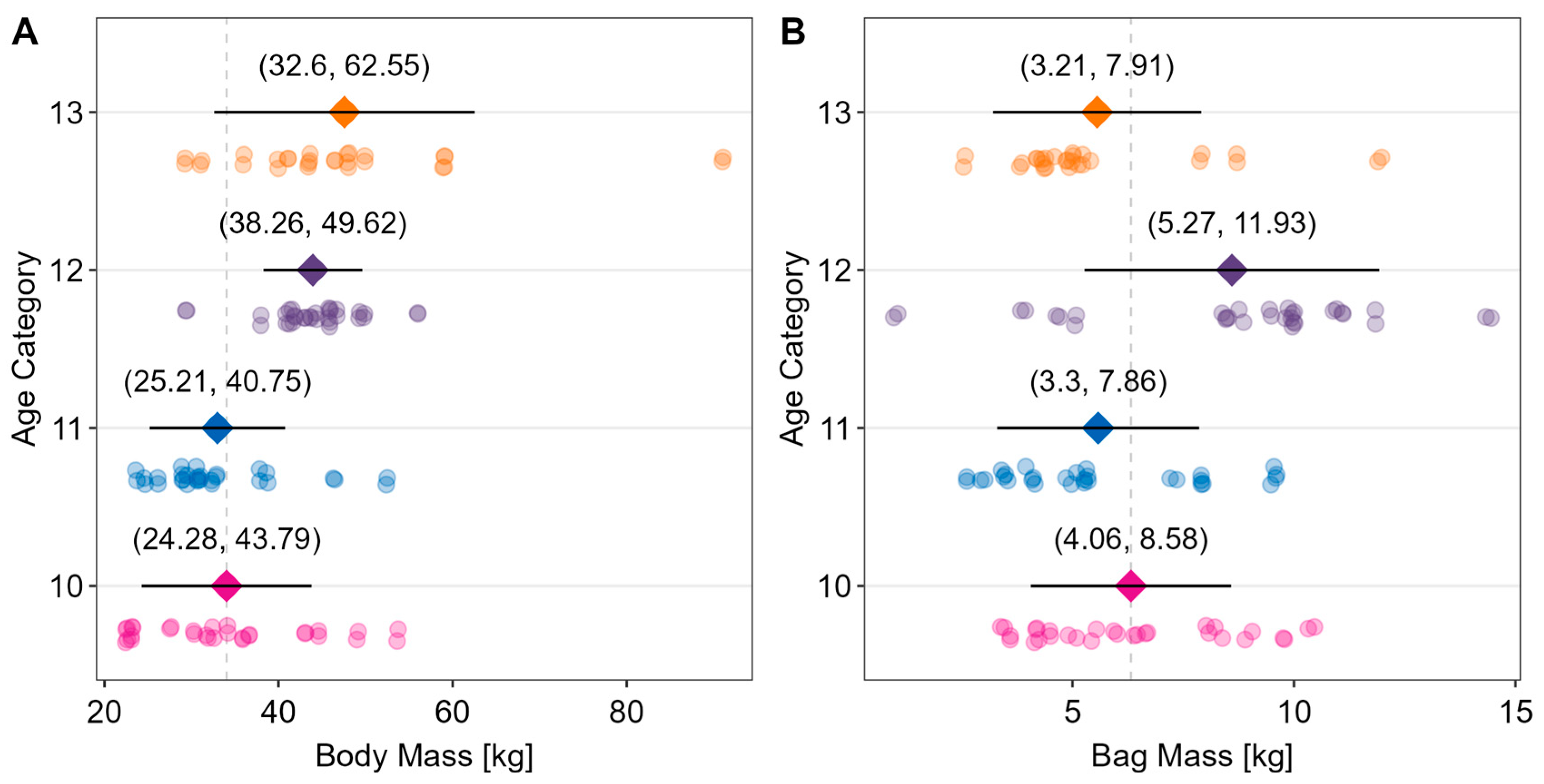
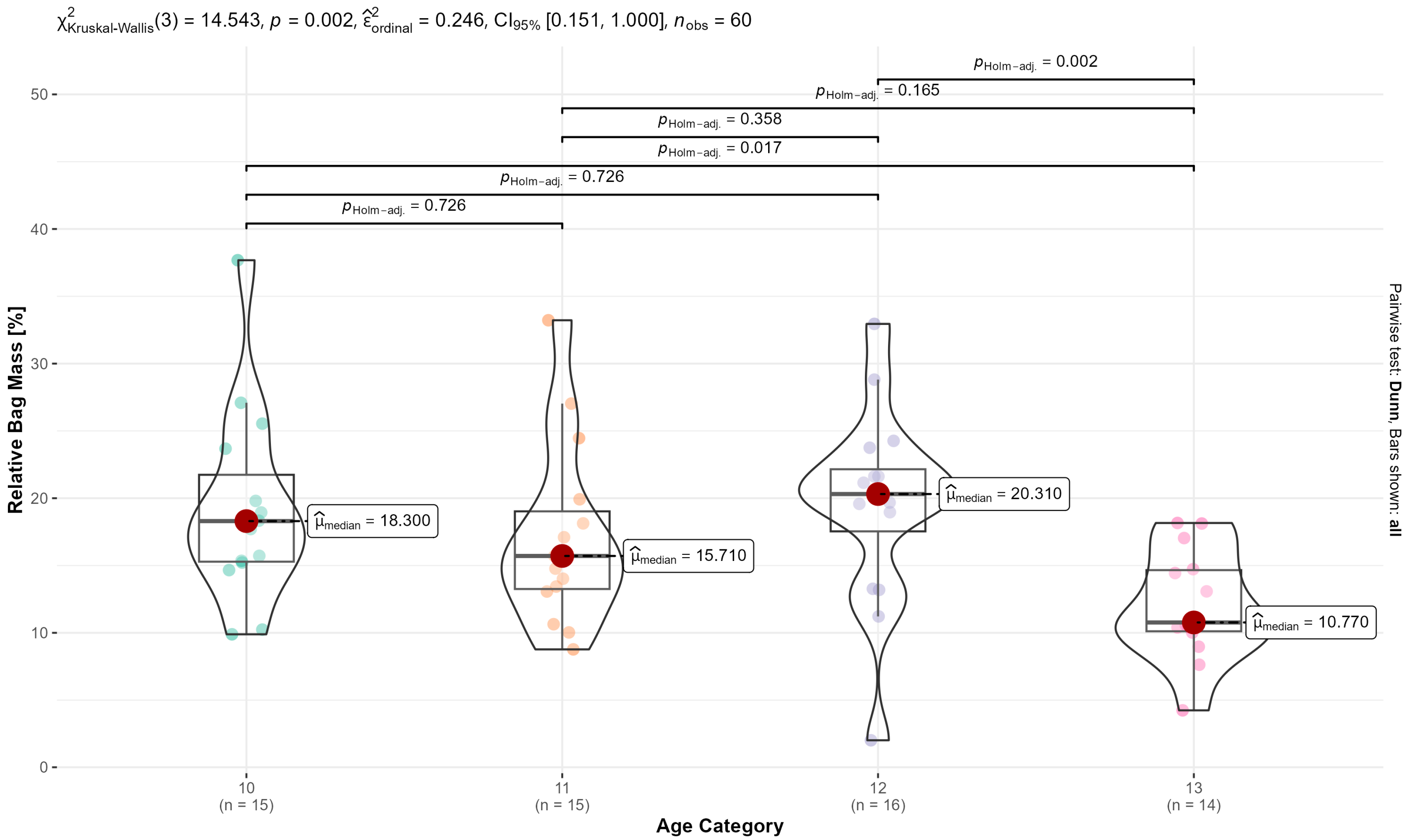
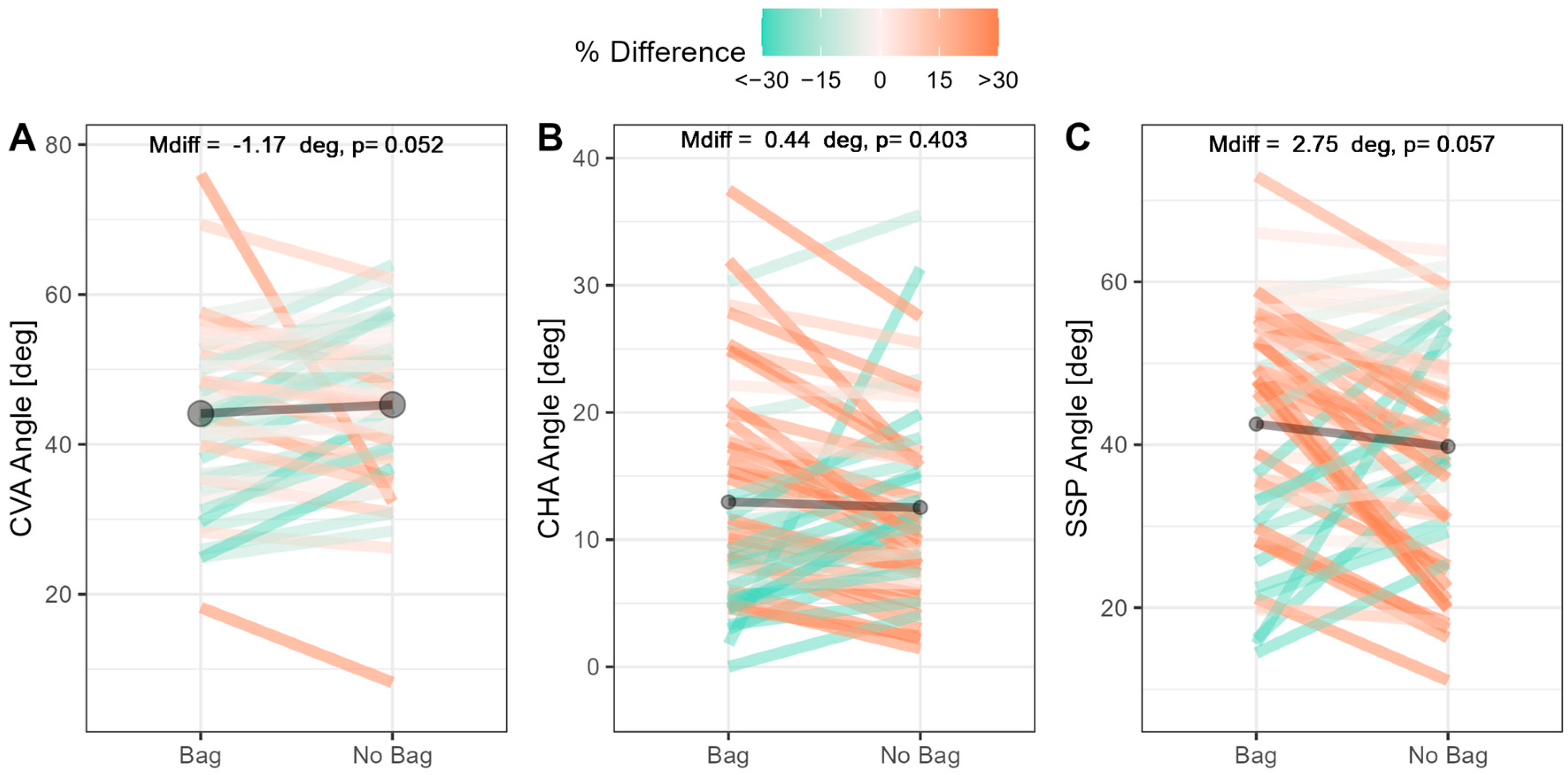
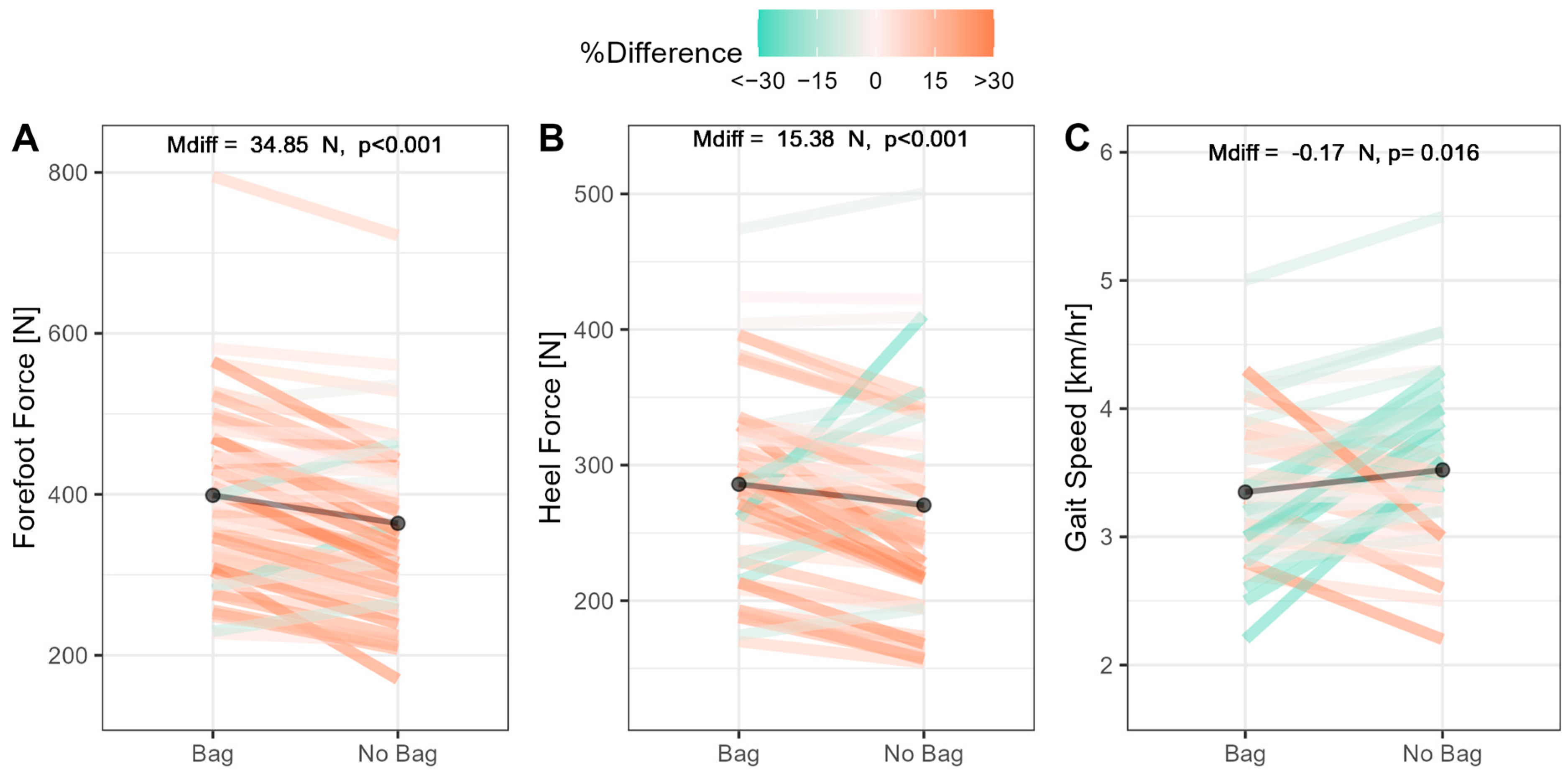


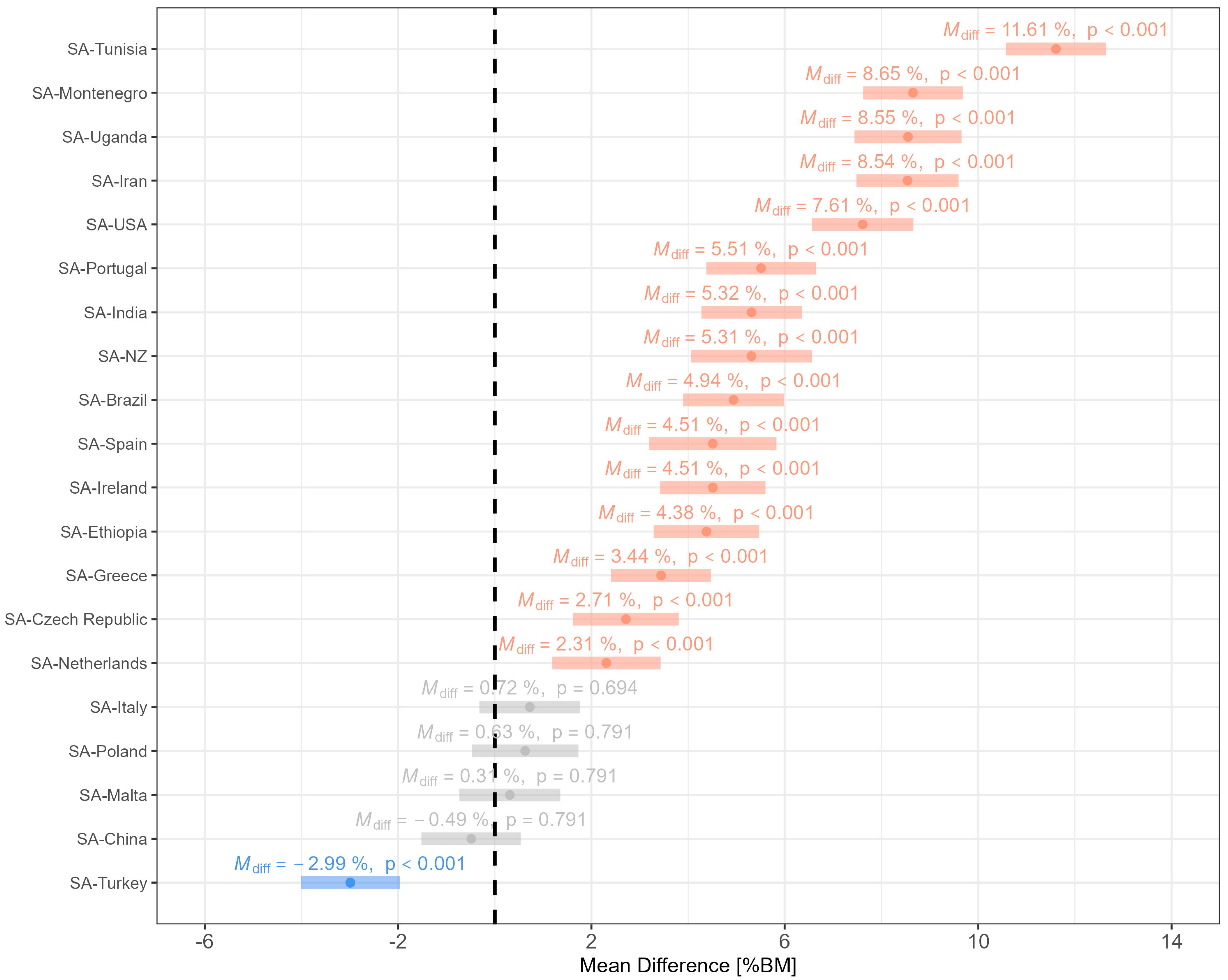
Disclaimer/Publisher’s Note: The statements, opinions and data contained in all publications are solely those of the individual author(s) and contributor(s) and not of MDPI and/or the editor(s). MDPI and/or the editor(s) disclaim responsibility for any injury to people or property resulting from any ideas, methods, instructions or products referred to in the content. |
© 2023 by the authors. Licensee MDPI, Basel, Switzerland. This article is an open access article distributed under the terms and conditions of the Creative Commons Attribution (CC BY) license (https://creativecommons.org/licenses/by/4.0/).
Share and Cite
Grobler, B.; Kramer, M. The Acute Effects of Schoolbag Loading on Posture and Gait Mechanics in 10- to 13-Year-Old Children: A Cohort from the North West Province. Children 2023, 10, 1497. https://doi.org/10.3390/children10091497
Grobler B, Kramer M. The Acute Effects of Schoolbag Loading on Posture and Gait Mechanics in 10- to 13-Year-Old Children: A Cohort from the North West Province. Children. 2023; 10(9):1497. https://doi.org/10.3390/children10091497
Chicago/Turabian StyleGrobler, Bridget, and Mark Kramer. 2023. "The Acute Effects of Schoolbag Loading on Posture and Gait Mechanics in 10- to 13-Year-Old Children: A Cohort from the North West Province" Children 10, no. 9: 1497. https://doi.org/10.3390/children10091497
APA StyleGrobler, B., & Kramer, M. (2023). The Acute Effects of Schoolbag Loading on Posture and Gait Mechanics in 10- to 13-Year-Old Children: A Cohort from the North West Province. Children, 10(9), 1497. https://doi.org/10.3390/children10091497





